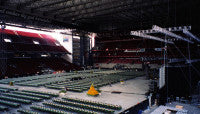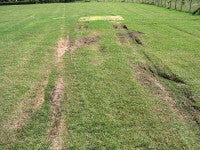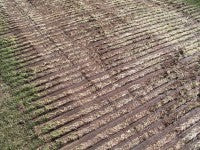Festivals, concerts and fairs
This article looks at the successes and problems often associated with such events and builds on our experience of the aftermath of large festivals such as the Isle of Wight festival (120,000 people over three days) to concerts in sports stadia. The article focuses on open space sites rather than those hosted in sports stadia.
Why use a sports pitch?
 The most obvious reason for using a sports pitch area is the size, which is able to accommodate large audiences and, therefore, generate significant income.
The most obvious reason for using a sports pitch area is the size, which is able to accommodate large audiences and, therefore, generate significant income.
However, there are other reasons that are more subtle. The environment of a sports pitch, in a mature parkland setting or attractively landscaped area, gives a significant ambience. The location is, invariably, as essential as the need for space. There is nothing more appealing than a summer evening of jazz outdoors with well designed lighting on trees, background architectural features and historic houses. I digress.
Large stadia also have great presence and make excellent venues for concerts, boxing and the like. Much of the existing seating in a stadium also provides ideal viewing of the stage, this being appropriately supplemented with imported seating for the pitch area.
Sometimes, open spaces, as often found in many public parks, are used for fairs and circuses. Such sites can tend to be less controlled, which may result in concentrated wear in certain locations such as some walkways.
Management
It is probably worthwhile, at this stage, to talk about site management. Most large scale events would be managed by a specialist company. Essentially, the site is "rented" to the company for a set up period prior to the event, and returned after break down. For the privilege, the company pays a fee, which could be set or related to the number of tickets sold.
 Of course, the requirements of the local authority, the utility companies, the police and emergency services, and other government agencies will have to be met and ensured - a key requirement which must be satisfied. Assuming there are no problems in an event going ahead as long as statutory requirements are met, a clear contract needs to be carefully prepared to ensure that the pitches are returned to the same state as they were received, with the hiring company being responsible for all costs and works necessary to achieve this.
Of course, the requirements of the local authority, the utility companies, the police and emergency services, and other government agencies will have to be met and ensured - a key requirement which must be satisfied. Assuming there are no problems in an event going ahead as long as statutory requirements are met, a clear contract needs to be carefully prepared to ensure that the pitches are returned to the same state as they were received, with the hiring company being responsible for all costs and works necessary to achieve this.
If such restorative works and costs by the hiring company are overlooked there may be large costs that would have to be borne by the site owner, and that could devastate the profits. It would be well worthwhile employing an agronomist prior to and after the event to identify the risks and to provide remedial advice. This would be best done with both the concert company and the site owners in attendance to agree and document actions.
As an aside, comprehensive insurance will be needed to cover third party and cancellation risks, and often insurances are taken out to cover possible weather effects. Public performance licences will also be required. Specialist event companies will tend to arrange this as necessary.
In order to look at the probable issues for say a festival, the criteria would be set-up, parking and transport, the event itself, post event break down and remedial actions.
 It is probably worth noting that the timing of an event is critical to recovery. In situations where irrigation is not available, then the earlier the event is held during the growing season, the more time there is for recovery. Following midsummer events, pitch recovery can be difficult if the weather becomes dry.
It is probably worth noting that the timing of an event is critical to recovery. In situations where irrigation is not available, then the earlier the event is held during the growing season, the more time there is for recovery. Following midsummer events, pitch recovery can be difficult if the weather becomes dry.
Set-up
This involves the bringing in of large items such as the stage, concessions marquees, toilet blocks, caravans, etc. To allow this, there will need to be basic structural installations such as roadways, water pipes and possibly electrics. Sewerage options will also need to be considered.
On the face of it, this seems relatively simple with good planning and site management. However, it is my experience that roadways are rarely put in the right places and are often not wide enough. Typically, roads are plastic or steel sections laid onto the turf to support the load. This is fine in dry conditions but, in wet years such as the last two summers, it could mean the road is compressed into the turf. Tight turns often mean that vehicles which drive off the roadways can then get stuck. The damage that even a small laden lorry can do to a sports pitch is heartbreaking, leaving ruts or trenches often 300mm deep and even completely flattening drainage pipes below the surface.
The solution is easy. Route roadways, if possible, off pitches and ensure they are wide enough on corners. Also make sure that someone is directly responsible for marshalling vehicles to avoid off-road ventures. There may be some merit on areas of excellent quality turf to remove and store the turf for future replacement.
The road may prevail for up to a month for a big event and this will invariably mean the grass will be dead underneath. Ensure at the planning stage that grass replacement via seed or turf is budgeted for.
On larger concert venues where a pitch is covered for seating, aim to keep the covers down for the least period possible. Humidity under the covers can cause rampant disease and a preventative fungicide treatment needs to be considered. Some of the rigid plastic covers are translucent and this can help keep the grass healthy.
A final important aspect is to keep a record of all trees, roads and features as damage inevitably occurs. Photographic records are one good way of retaining irrefutable records.
Car parking
 This is always potentially difficult as the vehicle numbers and weather always mean the results are unpredictable. As with the main set up, planning is essential. The access routes need to be flat, straight and logical to ensure the maximum number of vehicles can be accommodated. In a tarmac car park. a car parking space is normally 2.4 x 4.8 metres. This would need to be enlarged significantly for turf - even with stewarded parking, most people don't want to park close to another car.
This is always potentially difficult as the vehicle numbers and weather always mean the results are unpredictable. As with the main set up, planning is essential. The access routes need to be flat, straight and logical to ensure the maximum number of vehicles can be accommodated. In a tarmac car park. a car parking space is normally 2.4 x 4.8 metres. This would need to be enlarged significantly for turf - even with stewarded parking, most people don't want to park close to another car.
The grass should not be longer than 75mm, as there could be a fire risk in dry conditions, and the main routes either boarded or marked out. Disclaimers for damage to cars not being the landowner's responsibility are essential to prevent costly claims.
The main damage will be surface loss of grass in the high traffic routes, possibly compaction and sometimes oil contamination. The difficulties occur in very wet conditions on heavy soils as vehicles can get bogged down leaving deep ruts.
The Event
It never ceases to amaze me the damage people can cause. Generally, with heavy foot or vehicular traffic, the grass is worn away and compaction occurs. Fortunately, this tends to be surface damage and can be alleviated by decompaction, fertilisation and overseeding.
 Where drinks are available they should be in plastic bottles with plastic caps. Glass and metal caps are impossible to fully remove and can cause significant injury. Even so, plastic caps by the thousand can be pushed into the turf and need to be removed. This is the same for any other litter.
Where drinks are available they should be in plastic bottles with plastic caps. Glass and metal caps are impossible to fully remove and can cause significant injury. Even so, plastic caps by the thousand can be pushed into the turf and need to be removed. This is the same for any other litter.
The grass around concessions can be scorched from hot drinks and diesel from generators. Where grass is damaged by hot water, drinks, etc. then reseeding the area is normally required. If there are diesel/petrol spills, then the effect will need to be assessed. There may be a requirement to notify the Environment Agency, especially if there is any risk of the pollutant entering a watercourse. Small spill can be treated with oil eating bacteria, or the soil replaced and the contaminated soil removed to a licensed landfill. Appropriate documentation will be required for this.
Areas around portable toilets often get sewage spills. This grass should be treated as toxic to health and ideally not used until sunlight has had about a month to kill off bacteria. The areas can be flushed with clean water. Serious spillages may again require the Environment Agency being notified. On a positive note, the nitrogen within sewage may help the grass to grow well!
Break down
Damage can occur as the site organisers are trying to get off site as quickly as possible. Similar problems can occur as for the set-up in terms of vehicle movements. The aim is to remove all items covering the grass as quickly as possible, but in a manner that is controlled and careful. I like to see the same team involved in the build employed for the break down.
 Once the site is clear the whole area needs to be litter picked removing all items, especially those pushed into the soil.
Once the site is clear the whole area needs to be litter picked removing all items, especially those pushed into the soil.
Remedial works
When cleared, a full site walk is essential to assess the damage caused. Ideally, an agronomist should be present. The damage will depend on the weather during the event, the grass condition pre-event, the number of visitors, the soil type, etc.
Normally, the site will be worn but the grass may not be completely killed. The typical repair action would be to harrow or rake the areas to lift any flattened grass, decompact the surface, fertilise and overseed at a rate dependent on the wear. Bare ground could need 40-50g/m2 of a ryegrass type mixture, whereas slightly thinned grass could require 25-30g/m2.
The seed should be slit seeded in two or three directions. Small areas could be returfed, but this often tends to be outside the budget and, as long as there is sufficient time for recovery before play, it is generally unnecessary.
The rate of recovery can be greatly enhanced by irrigation if rainfall does not occur in any quantity.
There is a likelihood that the whole site will be compacted through the footfall of the audiences. This will need to be relieved via vertidraining or the use of other types of decompaction tools. The choice will be dependent on the level of compaction and would be best advised through your consultant.
Areas of roadways are often dead after an event and can be very compacted. Sometimes, the only way forward is to cultivate and reseed, although multiple decompaction passes and disc seeding may be adequate.
If there are any deep ruts, these could be lifted out manually and then topdressed smooth with appropriate topsoil before being seeded. Filling ruts with soil will not remove the deep compaction and the old rut may hold water later. If a rut occurs over a drain line then the area should be excavated to check the drain has not been damaged. Repairs should be made and the area reinstated. Areas of contamination should be dealt with accordingly.
As mentioned earlier, the above operations can be very expensive and should be built into the project costing.
Finally, any damaged trees should be pruned or replaced.
Conclusion
The use of pitches for events can be financially lucrative and will continue to be culturally important. However, the event needs to be carefully managed and the risks evaluated. Contracts need to include remedial costs and works, and do not forget to include a contingency sum to cover the unexpected.
Steve Gingell, STRI Southern Area Manager
www.stri.co.uk
